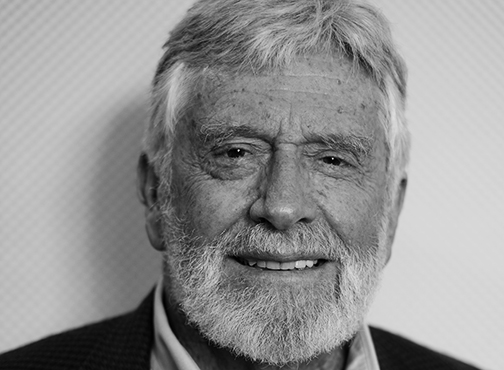
In 1971 two friends Richard Sanford and Michael Benedict, chased their dreams of making world class wine and planted vines in the Sta. Rita Hills in Santa Barbara County, California. They ignored the common viewpoint that the region was not climatically suited to successfully growing Pinot Noir. Since then, they have been proven correct and Pinot Noir in the Sta. Rita Hills is regarded both a critical and commercial success. The original vineyard they planted, the Sanford and Benedict Vineyard, is considered one of the most historically significant vineyards in California.
Grape Collective talks to Michael Benedict about his passion for Pinot Noir, the development of the Sta. Rita Hills wine region and his unique path in the wine industry.
Christopher Barnes: Michael, how did you start your wine journey?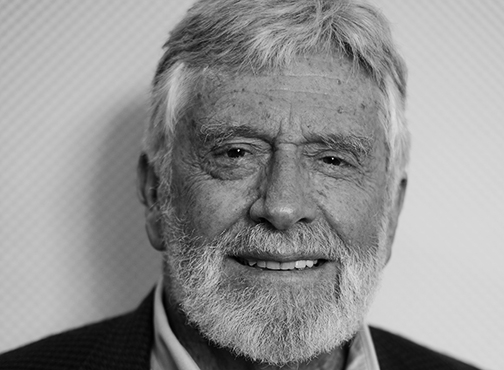 Michael Benedict: Well, it's not one thing and not one event. The beginning of the wine journey had to do with sort of favorable economic circumstances. There was a big interest in vineyards and wine back in the late sixties, 1969, 1970. In university I had been very interested in climate, and the relation of distribution of plants to climate, how climate influenced where plants grew in the world. I knew a bunch about that sort of thing. I was living in a place where there was an old vineyard out on an island off the Santa Barbara coast that had been a very successful vineyard in the 19th century. Great grapes had grown and yet it was only a mile and a half from the coastline. Very near the ocean. Yet the climate in this area, and this is where the vineyard was, was very much more like the climate in the interior, like you would find in the Santa Ynez Valley, or the Sonoma Valley, or the middle Salinas Valley. It was not maritime, even though it was adjacent to the water. What kept the maritime climate from getting in and kind of clouding over the vineyard was the mountain ranges. Two thousand feet on the north, and 1,500 feet on the south.
Michael Benedict: Well, it's not one thing and not one event. The beginning of the wine journey had to do with sort of favorable economic circumstances. There was a big interest in vineyards and wine back in the late sixties, 1969, 1970. In university I had been very interested in climate, and the relation of distribution of plants to climate, how climate influenced where plants grew in the world. I knew a bunch about that sort of thing. I was living in a place where there was an old vineyard out on an island off the Santa Barbara coast that had been a very successful vineyard in the 19th century. Great grapes had grown and yet it was only a mile and a half from the coastline. Very near the ocean. Yet the climate in this area, and this is where the vineyard was, was very much more like the climate in the interior, like you would find in the Santa Ynez Valley, or the Sonoma Valley, or the middle Salinas Valley. It was not maritime, even though it was adjacent to the water. What kept the maritime climate from getting in and kind of clouding over the vineyard was the mountain ranges. Two thousand feet on the north, and 1,500 feet on the south.
In the summertime, which is our growing season, the marine layer is usually about 1,100 to 1,300 feet thick. At 1,300 feet in elevation it can't get over the top of the mountain. It just goes in as far as it can, and when it hits the mountain, it stops there. It doesn't matter whether you're 50 miles from the coast or one mile from the coast. When you get on the other side, it's dry and warmer. So I learned about this effect that the marine influence had on the good wine growing areas in California because that's why the Napa Valley is relatively cool, because it has a certain ventilation from the bay.
You go to any of the great vineyard areas in the world where there are particular varieties known, I think you will find that every case, the finest expression of that particular variety in that area will be the coolest place within that area. Beyond which a little bit cooler and you can't grow the wine grape. It's too cool. Just back a little bit from too much fog, too much cool. That's where the grand cru of almost any variety in the world occurs. That was, that's just an obvious thing that, if you read and look at the literature, look at the climates, and look at the wine maps, you can put all this together.
When we started, we had some friends who were willing to finance an operation. They didn't know what kind of a vineyard operation. We had nothing particular in mind in Santa Barbara County. I was at the university at Santa Barbara and at that time we knew a lot about the setting of this valley. We knew that there was a lot of capital available for establishing vineyards. So in the very beginning we said, well, let's try that. Let's do something. But what the something was, was not yet determined.
We bought some cuttings from the only modern, the other modern vineyard at that time in Santa Barbara County, the old DeMateo Nelson vineyard. They had planted, started planting I think in 1964. They planted Riesling, Cabernet Sauvignon, Sauvignon Blanc, and they were selling their grapes to the Napa Valley at very good prices.
The quality of the grapes was quite good. The numbers, the acid sugar, the pH balance, all the harvest numbers were wonderful. I went up to this winery in Napa Valley and talked to the winemakers to ask them. They didn't know about the political issues that their management had imposed. They were very open about it. While these grapes come up from Santa Barbara County and they have this sugar, this amount of sugar. This total acidity, this pH, and the numbers were terrific. Cabernet Sauvignon and Riesling. We thought, well that's a safe bet.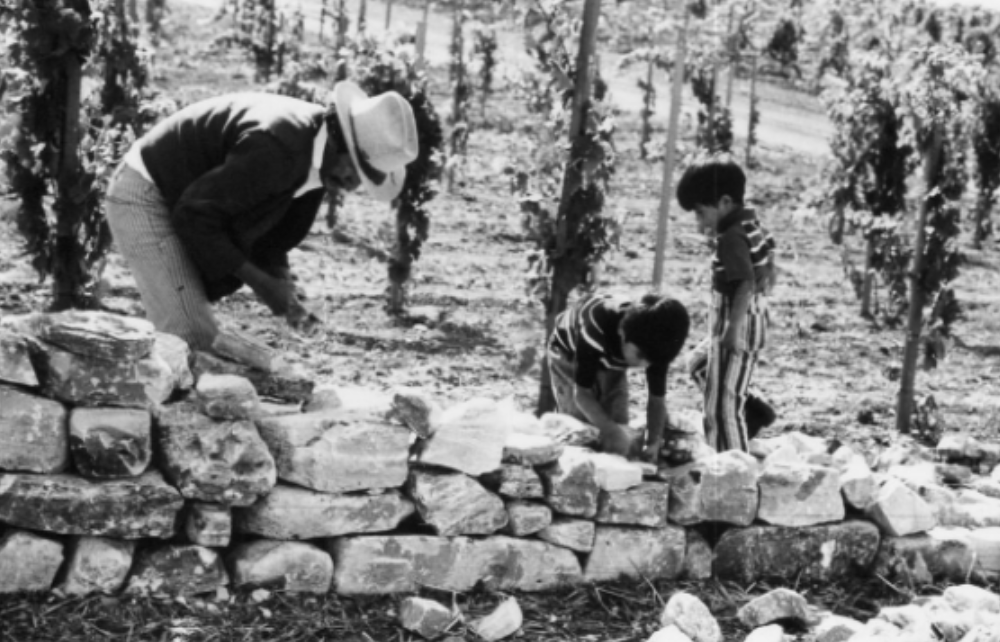
(Cellarmaster Auggie Rodriguez and family at Sanford & Benedict Vineyard in 1972)
We'll just make more Santa Barbara County Cabernet Sauvignon and Riesling. So we bought a bunch of cuttings that year in 1971...late 1970. We bought the cuttings and planted them out in a nursery in the Solvang area. And during the year that we were putting roots on our nursery, I started exploring seriously. Okay, we've got a nursery, we've got plants coming in, what to do with it. We've got these babies coming, we've got to find a place. Got to find a place. What place? Well during that time, I had the opportunity to get to know some people in Los Angeles who had very good wine cellars, deep cellars. They had lots of good Burgundy and of course they were raving about Burgundy.
I drank some of that wine and I became a Burgundy raver as well. I did read a lot about Burgundy. And I knew that Burgundy was Pinot Noir and it was not what we had growing as nursery plants. But in pursuing Pinot Noir, the idea of Pinot Noir, both in Burgundy and the idea of Pinot and in California, found that Pinot Noir in California was kind of a lonesome child. Many vintners had grown it in the Napa Valley, Sonoma Valley, Mendocino County, many had tried it. Almost all the old names, the big names, the famous founders' names. Those three areas that had tried Pinot and they'd all abandoned Pinot. And yet, Burgundy Pinot was Burgundy. You go to Los Angeles and talk to the people who loved their wines and knew a lot about wines and had good soul, you asked them, what is their favorite wine? It's always a Burgundy name.
All this excitement about Pinot Noir in the world, this fact that in California, very serious people had tried and kind of walked away from it. That was very challenging. That was interesting to me, because I was convinced then. Not from a viticultural point of view, but more from a botanical physiological point of view, that this difference between Burgundy and California had to be based on climate. Because when people talk the narrative about Pinot or about Burgundy, it's always about the acidity, the balance and the firm structure.
With California winemakers who make Pinot what was lacking was the acid. It's easy to get the sugar because it comes in really early in the season. It's way too hot. The acids are already shot by the time the sugar gets to 22 brix or 23 brix. From a physiological point of view, I suspected strongly that that had to do with the climate. The effect of climate on the physiology of the vine. What happens when grapevines get too hot? We don't need to go into that physiological stuff, but it was all there easily seen by somebody who was interested enough to see it.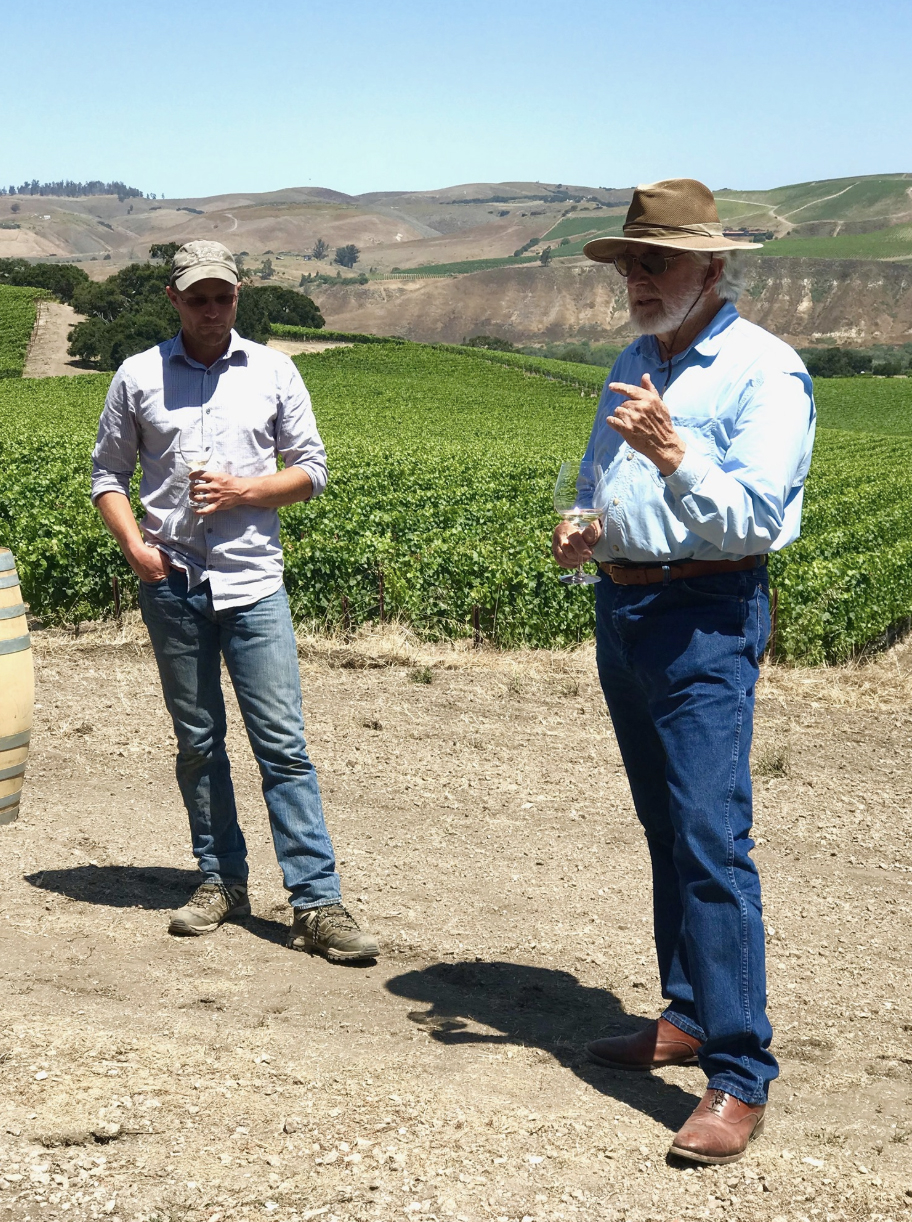
(Michael Benedict at the Sanford Winery)
I just dug into it and found it. Why make more California Cabernet? We have our nursery planted. We're sort of committed in a way to Cabernet, but the real challenge, it's Pinot Noir. Somebody can do Pinot Noir in America really well. As good and as well as the Burgundians and that will be a real accomplishment. That's worth going for. Planting a vineyard just to grow more California Cabernet in Southern California, that's no big deal. Anybody can do that. So it was kind of a counter counterpoint to what was going on in California at the time.
How did you know that the spot that you found was really the right spot for Pinot Noir?
Studying the climate. The starting point at the very beginning of the undertaking was understanding if climate has to do with the structure of Burgundy, but if you have a great acidity of Burgundy, what is the climate then? Does climate have to do with that? So, the Frenchmen were taking good climatic records in Dijon for almost 300 years now, there was a great record of highs and lows each day of the year. How hot did it get, how cold did it get around the year. Around 365 days. It was easy. All you have to do is read through that and see that when the Napa Valley where Louis Martini was committed, in the Sonoma Valley where all those other guys were committed, they get daytime temperatures in August where it gets to be 105, 108, sometimes 110.
You read the climate records in Dijon, maybe two times in 100 years, will the temperature get to be even 100 degrees. It's just much cooler. There's nothing hidden about it. It's just you've got to look at it and see that Burgundy is just a much cooler growing climate than the Napa Valley, Sonoma Valley, Mendocino. Of course, the Central Valley is way too hot.
The first thing came across looking at climate was that, well, we've got to find a cooler place. Where might that cooler place be? And what conditions are required? It's not just cool, it's not just temperature. Because the grapevines need sunshine, especially during a blooming period, which is going on right now in Santa Barbara County.
But May, June, those months. You need lots of sunshine. So the challenge is to find a really cool place where there's lots of sunshine, that has a long enough growing season. Now you can find cool places with lots of sunshine if you go up so many thousand feet in the high Sierras there. Beautiful growing climates. But that season would be eight weeks, 10 weeks at the most. Half of what you need in order to mature your grapevines. You can go to places where the climate is perfect from a thermometer's point of view, and look at them and what's the problem?
No sunshine. They're so near the coast that the fog, the gloom that comes in during those months where you need lots of sunshine. May, June, early July. There are lots of places in California that are cool, but they're not cool and sunny. There are lots of places in California that are sunny, but they're not sunny and cool. The trick is find a sunny, cool place. And what you have to do is find a place that is cool because it's close to the ocean, but far enough inland that the marine layer is already dissipated by the time it gets in there. And that's a matter of 10, 12, 15 miles depending on the geography of the place.
I looked at these coastal valleys from Santo Tomas in Baja, California, Guadalupe Valley, up through San Diego County. There's nothing in San Diego County, LA County, Orange County. They're probably little places where you could grow varieties that like more heat. It gets warmer in the summertime.
Coming up north the San Ynez Valley, the Los Alamos Valley, and the Santa Maria Valley. Three adjacent valleys, all face into the ocean and all run east and west. That and the prevailing winds from the northwest, the prevailing wind penetrates those three valleys differently, each one because the width of each one is different, but they go as farther in. The San Ynez Valley stays closer to the coast and the Los Alamos Valley.
You go up north Monterey County, there are some beautiful wine growing climates that are only now being really developed. At the foot of the Santa Lucia range and up north of Soledad between Soledad and Salinas, there are some beautiful climates in there.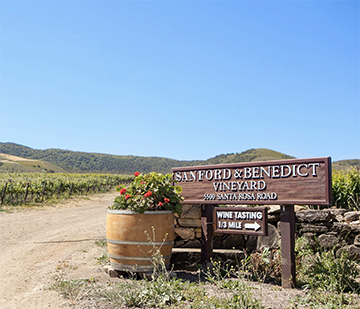 I didn't pay much attention to it because there was something about that vast, wide open windswept aspect of Salinas Valley that was not good because grapevines respond to wind like they respond to heat as well. It gets too windy. They're losing water through evaporation. They stop photosynthesizing. When the temperature gets high, when it gets up about 80, 81, 82 degrees, photosynthesis shuts down the stoma. Because stomates close, there's no gas going in or coming out. The plant switches over to a metabolism that uses malic acid as the energy source and that's where our acid goes. Any variety and when it gets too hot or too windy, the acid is consumed in the plant's 24-hour respiration.
I didn't pay much attention to it because there was something about that vast, wide open windswept aspect of Salinas Valley that was not good because grapevines respond to wind like they respond to heat as well. It gets too windy. They're losing water through evaporation. They stop photosynthesizing. When the temperature gets high, when it gets up about 80, 81, 82 degrees, photosynthesis shuts down the stoma. Because stomates close, there's no gas going in or coming out. The plant switches over to a metabolism that uses malic acid as the energy source and that's where our acid goes. Any variety and when it gets too hot or too windy, the acid is consumed in the plant's 24-hour respiration.
So you know, it began to be clear what the relationship was with climate and the acidity, plant physiology, what the plants need, where to grow. Salinas Valley, we started with winds, high velocity winds, Salinas Valley, which is pretty amazing. And then you go up to the Bay area, they're beautiful wine growing climates around the Bay area. You could grow Pinot Noir on Alcatraz Island beautifully if all you had to do is worry about temperature. But when you bring in the sunshine, that's what you have to have and there's no sunshine. It's just way too gloomy, too foggy. You get up in the Napa Valley, what's different about Napa Valley? Some of Sonoma Valley, Petaluma area, the Anderson Valley, all of those and Mendocino County areas. They all have a barrier of the coast range between the ocean and the valleys.
The valleys are warm and hot because the marine layer comes in and hits that 1,400-foot mountain and it just stops there. You get on the other side, it gets warm very fast. All the coasts, near coast valleys, in the north-central coast are very warm. They're very warm, much warmer than our San Ynez Valley, and then you look at the whole spectrum of things you see that the south-central coast, farther south you'd expect to be warmer but they're actually much cooler because they're open to the ocean. They embrace the sea wind much more completely, more openly, and that keeps things cool. The task then, measuring these places in these coastal valleys. And where it is kind of like Dijon and Beaune. It was really clear that Santa Rose Road area out west from Sanford Benedict West, the daily temperatures rarely got over 78, 79 degrees. In August and September they would get up to that but wouldn't go over that. Eighty degrees is really the threshold.
Michael, you looked at a lot of different areas in California, and you found this place where the climate worked for Pinot Noir. How did you find that specific spot?
Well, just driving up and down the roads, finding a zone and looking at the land. Some land is extremely steep, some land is river bottom land. There are lots of kinds of land, and these climate zones, and there was this very prominent, beautiful, big, rolling, north-facing, rolling slope that was there that, anyone driving by would say, "Wow, that's beautiful." And if you postulate, we got to be within a mile or two of here, what's the best looking place? And everyone would say ... everyone, I would say, Richard would say, our friends would say ... "Wow, that's the most beautiful place." And it was. And that's when we started seriously pursuing it and found that it was available.
The previous owner had bought it on speculation that there was going to be lakeside property. They were going to build a dam farther to the west, and it was going to flood the river, and it would be lakeside property. And that was finally laid to rest by the water resources board. That wasn't going to happen. So this guy had invested speculatively, and he was happy to sell it. So we made him an offer, based on just, kind of, calculating what was had cost him up to then, his carrying costs. We did a lease option on the property for five years, and started planting vines.
We planted the vines, the original vines from our nursery, Riesling and Cabernet. But by that time the Pinot Noir, Chardonnay thing had already kind of bubbled up in my head, and I had already made contact with people about cuttings and rootings of those things, those two varieties. So we brought in a whole lot of Pinot Noir rootings from Wente that weren't the Wente Clone they were from the old Paul Masson ranch in Saratoga, the original Paul Masson vineyard, vines that he had brought over from France, from Chambertin, that he planted in the 19th century. They were still there from the Martin Ray estate. Martin Ray purchased that vineyard from Paul Masson, and some huge company purchased the name Paul Masson, so they were a different thing.
Carl Wente was a protege of Martin Ray, a friend of Martin Ray. When the Wente family established their Arroyo Seco vineyard, they had been in Livermore. They still are in Livermore. They wanted a cool country outlie, they established the Arroyo Seco and they used the vines that Martin Ray had recommended from the old Paul Masson collection. They filled their nursery. They used all the plants. They filled up their vineyard, and had some plants leftover. And those leftover plants, we were able to purchase their rootings, bare roots. We purchased them, took them down, kept them for some months over the winter, and then planted them out in 1973.
And this wine was made from those plants that were planted in 1973, on their own roots. And two years later we had some little tiny round clusters, Pinot Noir, and I made a barrel of Pinot Noir, '75 vintage. It was delicious, and it got everybody's attention, because it just tastes so good. It was not great wine, but it was delicious wine. It was kind of remarkable, it had a lot of personality.

(Harvest at the Sanford Winery)
And based on that, our financial partners agreed to put up the dough to reconstruct our barn, turn it into a winery, which we did the winter of '75 and 1976. 1976 we made the first vintage Sanford and Benedict wine. And it turned out, you know, by late '77, '78, it was in the bottle, and it was very well received. There was a lot of talk about it, about the wine and also about how it kind of erupted out of this no man's land, this strange place where people hadn't grown vines. But the wines are great. They were from the get-go. They were really interesting and compelling. There was a character that still persists. Forty years later you can still, there's a commonality of flavor that has just been there, and that's from the place.
When did you know that it worked? When did you know, wow, we've really got something special here?
Well, I think the beginning was upon pressing that very first wine, that 1975 Pinot Noir, that it was just delicious to drink. It had great acid, everything about it, made from tiny little clusters and not a full harvest at all. These were baby vines. But there was something, it just had a lot of personality. And it was right there, in spite of the fact that all the authorities, the academics, had warned us that we would never get red wine grapes ripe in that climate, and way too cool they said, way too cool. You're wasting your money. You're wasting your partner's money. Anyway, it turned out the first grapes were delicious. And we went ahead and built a small winery. And from then on, the feedback on the quality of the wines was always very strong. Everything told us it was the right thing to do.
How would you describe the wines made from the Sanford and Benedict Vineyards?
Warm and complex. They have lots of parts in the aroma. Aromatics have many parts to them. And there's kind of a welcome warmness, I call it. I'm not talking about a temperature as much as a welcoming quality, and with a backbone of strong acid, good acid, good bones, and yet they were friendly bones, always have been. All the wines have been very friendly. Some have been higher alcohol, some are lower alcohol, but they all have a tremendous amount of extract. The character of the wine is in the extract. All the parts that are not water or alcohol, all those other things, color, aromatics, flavors. The vineyard produces a lot of that.
And it's still remarkable. Today we tasted a whole bunch of Sanford and Benedict wines. And to me, they all have that unique quality. And I think if you ask other winemakers who make wine from Sanford and Benedict, you will see that they all recognize that S and B quality. And they're described, people who have never seen the estate will write about it, and they use the same kinds of words. They'll talk about the balance, the depth, the character, the interesting quality to it. They're very nice wines, but you know, they're like my children too. I didn't make this wine, but I planted the vineyard that made this wine, and I have a fondness. But sometimes you become blind to your children's flaws. And I don't know if these wines have flaws or not. I don't think they do. I think they're perfect. And my friends think they're pretty good. And so that's what counts. What other people think about them.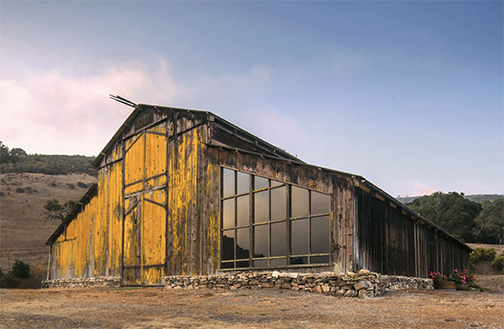
(Sanford Winery)
And how did you develop your winemaking philosophy?
Well, it wasn't a philosophy. I knew it was just simple logic that if you're going to play with Pinot Noir and Chardonnay, you have to learn to play Burgundian. And so I spent a lot of time reading about how the Burgundian winemakers do it. And not trying to get them to tell me how to do it. I just wanted, in every case, to hear them describe what they think is important. Then I kind of put all the stuff, the layers, together and figured that this was probably the most important thing, fermentation temperature, duration of fermentation, the amount of maceration. Pinot Noir has a relatively small amount of extract compared to other varieties, other popular varieties, Cabernet, Syrah; with Pinot, not much extract. You have to flog it a little bit to get the extract, but it's very easy to flog too much.
And I think one of the problems with the California Pinots in the north is that they were trying to get too much extract, and the wines did not have enough acid base. They have lots of flavor, and lots of tannin, and lots of you know, phenolic stuff, but they didn't have the acid structure to hold it all up. And so people didn't like the wines. They were flabby. Down in Santa Barbara County, at our Sanford Benedict estate, the wines have great acid, great balance, great extract. All the numbers. They're really, if you look at the numbers, if you have access to numbers of Burgundian wines, they're not open, as much as we are, about harvest numbers. But if you look at them, you'll see that S and B numbers compare much more to Burgundy than they compare to anything north of our vineyard in California.
A lot of that has to do with the winemaker's choice. When to pick. That's a key thing, when to pick. You know, Burgundians pick as late as they possibly can, before the hailstorm comes in, or before the rains come in. So, in order to get ripeness, they keep the vines on and on and on. What they consider to be ripeness would be 22%, 22 1/2% sugar. Twenty-three would be very high in the old days. Where in California, because it's so warm, it's easy to get 24, 25, 26 just like that.
When to pick? This idea of hang time, to me, is absolutely the wrong track. It's not the way to look at getting grapes ripe. If you need a lot of hang time to get your grapes ripe, what you need to do is find another place to grow your grapevines. That's almost always the answer. If the winemaking is weird, that it's consistently unreliable, unhappy, you have to find another vineyard. We were lucky enough to have found a great vineyard right in the beginning. And when you have a great vineyard making wine for you, it's easy to be a winemaker. It really is.
And what happened next? What happened with the Sanford and Benedict winery? Tell us a little bit about the story of the vineyard, and how the business evolved.
Well, Richard Sanford and I were business partners, and we had financial partners. And after about nine years, Richard decided that he wanted to leave, get out, he had other things. He got married, and there was a little bit of conflict, but it was nothing extraordinary at all, just the kind of thing where people have different goals. And Richard left. That was in the beginning of 1980. That was a long time ago, 39 years ago. And it's interesting that he went on two years later and founded the original Sanford Winery, and made wines in Buellton. And he had some partners put together a partnership, and they bought some land on Santa Rosa Road, quite a bit farther to the east of Sanford and Benedict. And he continued on and eventually, with still another business entity, established the winery on the current Sanford Winery. That was kind of two or three business iterations later. I don't know anything about them. What I know now is John Terlato and his family are the proprietors of both the Sanford Winery and Sanford and Benedict Vineyard.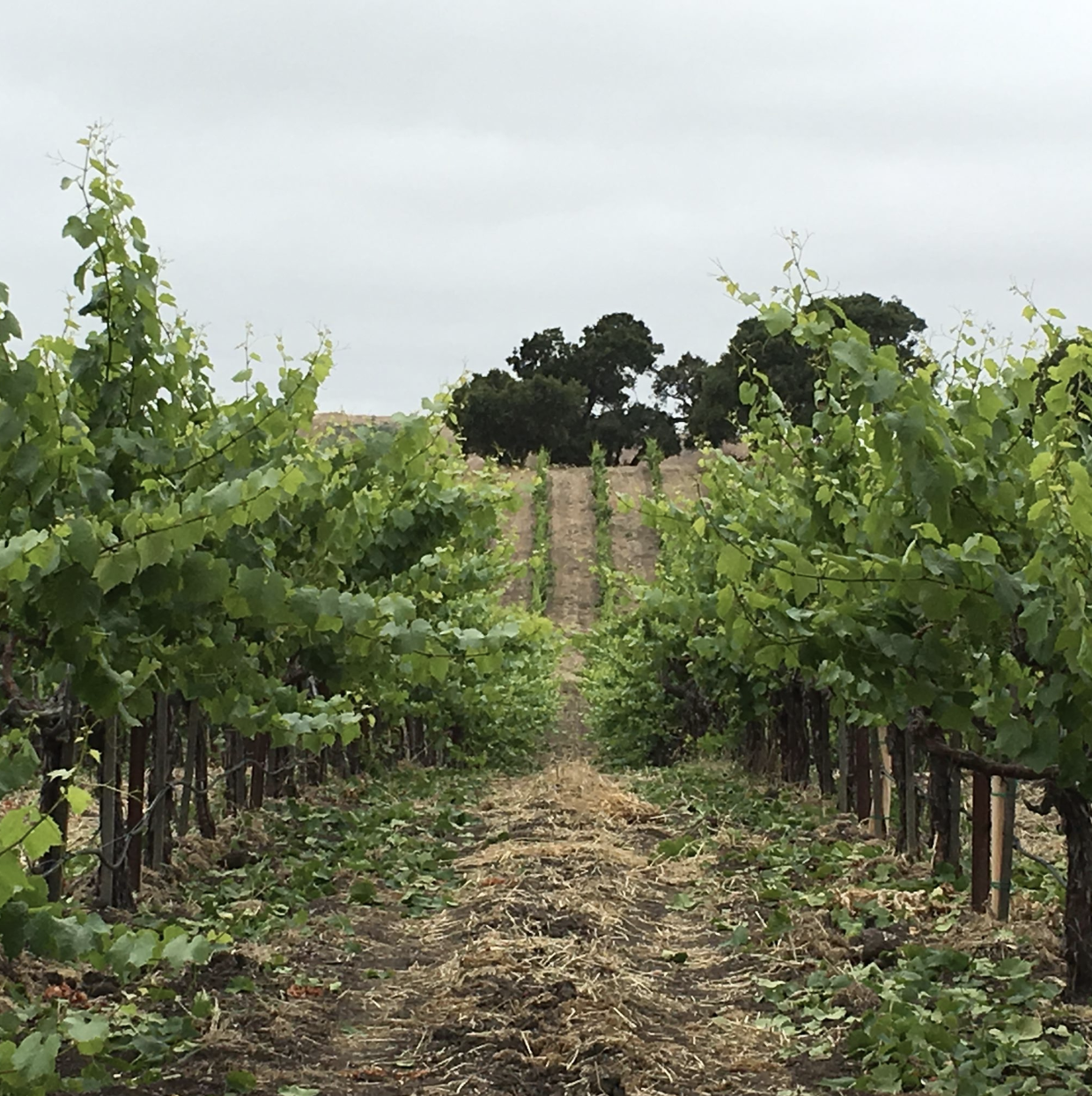
(The Founders Vineyard at Sanford Winery)
I sold in 1990, having been 21 years in the wine business, was ready to go on, do some other things that I wanted to do, which I did. And then more recently, in the last eight or nine years, I've come back in. Even more recently, been given the opportunity to become involved with Sanford and Benedict, and Sanford again. Sanford's the name now. Richard is far removed, but it's there. And the vineyard, I'm very proud of the vineyard, no matter who owns it. It's a great vineyard. And what I like about the current ownership is these guys know how great it is. And they're fully committed to making the wines that are really extraordinary. You know, the best, highest expression of that property. And the property has such amazing potential for making Pinot Noir and Chardonnay, not too many other things. It's completing the story from way back in the beginning when Richard and I had kind of pie in the sky goals. What if, what if, what if? And then life happens, and things happen, changes. But the original what ifs were really quite sound. They had a sound basis. And now I have the privilege, opportunity, to come back and kind of participate in the progress.
What is your role right now?
I'm a friend of John Terlato. That's my role. Yes, John and I talk all the time about grapes and wines and vineyards. And we even talk about wine salesmen wine, wine shops and things like that.
And if you were a young winemaker starting out today, I mean, everything's so expensive, right? Where would you go if you were a young winemaker today, starting?
Well, if you want to own a winery, or own a vineyard, you've got to do it the way we did. Only, you can't do in our neighborhood because the prices now are astronomical. But that approach, finding a place that is undiscovered, is probably going to be the most rewarding. And the other thing is to not spend all your time becoming educated academically about winemaking. Because very little of that will really bring success. None of it guarantees success. There are a lot of very well-trained winemakers who make kind of routine wine that's commercially acceptable. You know, there's a place for that. All of the wine we students drank, you know, we were very appreciative of the Gallos providing affordable wine that tasted good.
(Michael Benedict with John Terlato)
But if you have this concept of aspiring to something really wonderful, and a lot of winemakers do, you've got to hook up with a great vineyard. Can't be done without a great vineyard. And if you don't have a whole lot of capital, then you've got to do the exploration that I did in the very beginning. Kind of just find a place that's undervalued. No one thinks that wine grapes will grow there. But if you buy that place, you better be sure that you're right, that the wines will grow there. We were very fortunate that it turned out well. The gamble that we took turned out very well.
And talk a little bit about the Santa Barbara County area today, and other young winemakers out there whose wines you're excited about.
Oh yes. There are a lot of really wonderful wines being made in Santa Barbara County. The vineyard, in general, the Santa Barbara County vineyard, is really quite wonderful. Santa Ynez Valley, in particular, because it's the most varied. It has these zones, once you get farther away from the ocean, other varieties become more and more tolerant of the heat. We start with, out near the coast, the Pinot Noir, Chardonnay and Meunier that are grown rather near the city of Lompoc make beautiful sparkling wines.
Then the next zone in is the Burgundy zone, that S and B, by far, has the filet of that. It's for soil reasons, it's the only place in that neighborhood that, that's the only place that has that great soil and the climate.
What sort of soil is that?
Well, this raw, very rocky Monterey shale that was not deposited by the river. It's not a river or alluvium, it was an old landslide. So it's still hard, angular rocks, and extremely deep, 30, 40, 50, feet, maybe more than that. And that's one of the keys to it. Great vines have this amazing capacity to exploit a large volume of soil. And so if you give them a large volume of soil, they're able to get down there. And I think this has a lot to do with the concentration of the phenolics and aromatics, because each vine is using 30, 40, 50 yards of soil. So the soils here are great, but I want to go back in the Santa Ynez Valley in general, a little bit farther east becomes a nice, terrific zone for Cabernet Franc, Cabernet Sauvignon, Syrah. Then you get way east, and Happy Canyon where it's quite warm, Cabernet does very well out there. Merlot is a great variety, between Sanford and Benedict and Buellton, there's some great Merlot country. I have a little project with Pomerol as the goal rather than Beaune. Pomerol with a Merlot, Cabernet Franc and Cabernet Sauvignon, and very near the city of the Buellton makes beautiful, rich, complete wines, young vines.
Anyway, the Santa Ynez Valley has all of this. And so it makes it for a very interesting area, with a lot of diversity in winemaking techniques and winemaker personalities. There are a lot of young winemakers, which is really good. Some of our best wines are made by some of our youngest winemakers and our least experienced winemakers. Of course, everybody knows that probably the best wines are made by home winemakers because they take such care. You know, only 5% of them will be really good wines, but those 5% will really be exceptional, certainly at the highest level of commercial quality. It's all about how much attention you pay. Everything is.  Do you have a desert island wine?
Do you have a desert island wine?
Sure. Well, I can remember wines that I wish that I had 10 cases of, or maybe 100 cases. Yes. Well, great wine drinking experiences in my life, one of them, was an old Musigny from, made during World War II. The Musigny, unbelievable, fantastic wine. The old, whole vine Vieilles Vignes Françaises from Bollinger, for Champagne, little acre and a half vineyard, Pinot Noir own-rooted vines, makes spectacular, indescribable wine that's different from other Champagnes. It's just more of everything good about Champagne. I wouldn't mind having 30, 40 cases of that on my desert island. Old Champagnes, old Burgundies.














